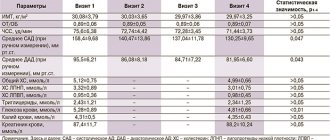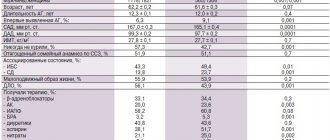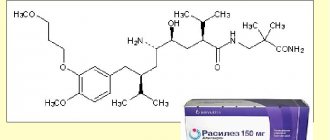Pharmacological properties of the drug Fozinopril
ACE inhibitor. Reduces the formation of angiotensin II from angiotensin I, which leads to a decrease in peripheral vascular resistance and systemic blood pressure. Suppresses the synthesis of aldosterone in the adrenal glands. The onset of therapeutic action is observed 1 hour after oral administration, the maximum reduction in blood pressure is achieved within 3–6 hours. The hypotensive effect persists for 24 hours, however, it may take 2–3 weeks to achieve a stable hypotensive effect in some patients. During long-term treatment, the effect persists. After oral administration, about 36% of fosinopril is absorbed in the digestive tract; the degree of absorption does not depend on food intake. Hydrolysis of fosinopril with the formation of pharmacologically active fosinoprilat occurs in the mucous membrane of the digestive tract and partially in the liver. The maximum concentration of fosinoprilat in blood plasma is achieved after 3 hours. Plasma protein binding is 95%. Does not penetrate the BBB. Fosinoprilat is excreted unchanged in urine and bile. The half-life is 11.5 hours. In patients with renal failure, there is no noticeable change in the pharmacokinetics of fosinopril due to a compensatory increase in its excretion by the liver. In patients with impaired liver function, a slight decrease in the hydrolysis of fosinopril is possible. There is evidence of a compensatory increase in the excretion of fosinopril by the kidneys with a simultaneous decrease in the hepatic clearance of fosinopril in this category of patients.
Fosinopril
Patients with malignant arterial hypertension or concomitant decompensated CHF should begin treatment in a hospital setting.
Before starting drug therapy and during treatment, count the total number of leukocytes and determine the leukocyte formula (once a month in the first 3-6 months of treatment and at periodic intervals up to 1 year in patients with an increased risk of neutropenia: with impaired renal function, systemic diseases connective tissue in those receiving high doses), as well as at the first signs of infection.
Before and during treatment, monitoring of blood pressure, renal function, plasma K+ concentration, Hb and creatinine, urea, electrolyte concentrations and the activity of liver enzymes in the blood is necessary.
Based on the results of epidemiological studies, it is assumed that the simultaneous use of the drug and insulin, as well as oral hypoglycemic drugs, can lead to the development of hypoglycemia. The greatest risk of development is observed during the first weeks of combination therapy, as well as in patients with impaired renal function. In patients with diabetes mellitus, careful glycemic control is required, especially during the first month of ACE inhibitor therapy.
Caution must be exercised when prescribing to patients on a low-salt or salt-free diet (increased risk of hypotension).
Safety and effectiveness of the drug in pediatric practice: it is recommended to carefully monitor newborns who have been exposed to ACE inhibitors in utero to detect hypotension, oliguria and hyperkalemia.
Neonates and infants are at risk of oliguria and neurological disorders, possibly due to decreased renal and cerebral blood flow due to the decrease in blood pressure caused by ACE inhibitors; Lower initial doses and close monitoring are recommended.
Care must be taken when driving vehicles or performing other work that requires increased attention, because dizziness is possible, especially after the initial dose of an ACE inhibitor in patients taking diuretic drugs.
Caution should be exercised when exercising or in hot weather due to the risk of dehydration and decreased blood pressure due to decreased fluid volume.
Before surgery (including dentistry), the surgeon/anesthesiologist must be warned about the use of ACE inhibitors.
When using the drug in the II-III trimesters of pregnancy, oligohydroamnion, hypotension of the fetus and newborn, oliguria and death are possible.
Side effects of the drug Fozinopril
from the digestive system: rarely - nausea, vomiting, dyspepsia, increased activity of liver transaminases; cases of pancreatitis and hepatitis have been described; from the respiratory system: cough, rarely - pharyngitis, laryngitis, sinusitis, bronchospasm; from the cardiovascular system: palpitations, chest pain, rarely - orthostatic hypotension, collapse, hot flashes, arrhythmia; allergic and immunological reactions - skin rash, itching, photosensitivity, angioedema, myalgia, arthralgia; from the urinary system - proteinuria, oliguria, disorders of excretory function, accompanied by an increase in the concentration of creatinine and urea in the blood plasma; other reactions - dizziness, fatigue, impaired taste and other types of sensitivity.
Fosinopril (Fosinoprilum)
Allopurinol.
Increases (mutually) the risk of neutropenia. Allopurinol increases the likelihood of developing Stevens-Johnson syndrome.
Acetylsalicylic acid
reduces the hyponatremic and hypotensive effects of fosinopril (a consequence of inhibition of prostaglandin synthesis in the kidneys with a decrease in renal blood flow and sodium and fluid retention).
Bumetanide
with simultaneous use, it enhances the hypotensive effect of fosinopril. The combined use of fosinopril and bumetanide in combination with a strict salt-restricted diet or dialysis can lead to a marked decrease in blood pressure, especially in the first hour after taking the initial dose of fosinopril.
Verapamil.
With simultaneous use, verapamil enhances the hypotensive effect of fosinopril.
Hydrochlorothiazide.
Strengthens (mutually) the effect.
Digoxin.
The bioavailability of fosinopril does not change when used concomitantly with digoxin.
Ibuprofen.
When used concomitantly, ibuprofen may reduce the antihypertensive effect of fosinopril, especially in patients with arterial hypertension and/or low plasma renin levels.
Indapamide.
Strengthens (mutually) the hypotensive effect, reduces potassium loss.
Ketorolac.
With ketorolac, the hypotensive effect is weakened (a consequence of inhibition of renal prostaglandins with a decrease in renal blood flow and sodium and fluid retention), and the risk of renal dysfunction increases, especially in patients with hypovolemia.
Magnesium hydroxide.
Concomitant use of magnesium hydroxide may reduce the absorption of fosinopril, so an interval of at least 2 hours is required.
Meloxicam.
Against the background of meloxicam, the hypotensive effect is weakened (a consequence of inhibition of renal prostaglandins with a decrease in renal blood flow and sodium and fluid retention); coadministration may increase the risk of renal impairment, especially in hypovolemic patients.
Methyldopa.
Fosinopril enhances the (mutually) hypotensive effect.
Metoclopramide.
The bioavailability of fosinopril does not change when used concomitantly with metoclopramide.
Naproxen.
Against the background of naproxen, the hypotensive effect of fosinopril is weakened (a consequence of inhibition of renal prostaglandins with a decrease in renal blood flow and sodium and fluid retention). Concomitant use increases the risk of renal impairment, especially in patients with hypovolemia.
Nimodipine.
Strengthens (mutually) the hypotensive effect.
Nitroglycerine.
Strengthens (mutually) the hypotensive effect.
Nifedipine.
With simultaneous use, nifedipine enhances the hypotensive effect of fosinopril. The bioavailability of fosinopril does not change when used concomitantly with nifedipine.
Piroxicam.
Against the background of piroxicam, the hypotensive effect is weakened (a consequence of inhibition of renal prostaglandins with a decrease in renal blood flow and sodium and fluid retention); coadministration may increase the risk of renal impairment, especially in hypovolemic patients.
Procainamide.
Fosinopril increases the risk of developing leukopenia when used simultaneously with procainamide.
Propranolol.
With simultaneous use, propranolol enhances the hypotensive effect of fosinopril. The bioavailability of fosinopril does not change when used concomitantly with propranolol.
Risperidone.
With simultaneous use, risperidone enhances the hypotensive effect of fosinopril.
Risperidone.
Strengthens (mutually) the antihypertensive effect.
Simethicone.
The simultaneous use of simethicone may reduce the absorption of fosinopril: these drugs must be used with an interval of at least 2 hours.
Spironolactone.
Inhibits the release of aldosterone, significantly increases the risk of developing hyperkalemia. Against the background of spironolactone, the hypotensive effect is enhanced.
Terazosin.
Fosinopril enhances the (mutually) hypotensive effect, a sharp drop in blood pressure is possible; when combined, it is necessary to reduce the dose.
Triamterene.
With the simultaneous use of fosinopril and triamterene, the risk of developing hyperkalemia increases: monitoring of the potassium content in the blood plasma is necessary. In patients with heart failure and diabetes mellitus, concomitantly taking triamterene, fosinopril increases the risk of increasing the concentration of potassium ions in the blood serum.
Furosemide
with simultaneous use, it enhances the hypotensive effect of fosinopril. The combined use of fosinopril and furosemide in combination with a strict diet limiting salt intake or dialysis can lead to a marked decrease in blood pressure, especially in the first hour after taking the initial dose of fosinopril.
Chlorthalidone
with simultaneous use, it enhances the hypotensive effect of fosinopril. The combined use of fosinopril and chlorthalidone in combination with a strict salt-restricted diet or dialysis can lead to a marked decrease in blood pressure, especially in the first hour after taking the initial dose of fosinopril. The bioavailability of fosinopril does not change when used concomitantly with chlorthalidone.
Celecoxib.
When used concomitantly, celecoxib may reduce the antihypertensive effect of fosinopril, especially in patients with arterial hypertension and/or low plasma renin levels.
Cyclosporine.
When used concomitantly with fosinopril, cyclosporine increases the risk of developing hyperkalemia.
Ethacrynic acid.
In the initial period of joint therapy with fosinopril, you should stop taking ethacrynic acid or reduce the dose of fosinopril to avoid severe arterial hypotension. Against the background of fosinopril, the hypokalemic effect of ethacrynic acid is reduced.
Ethanol.
When used simultaneously with ethanol, the hypotensive effect of fosinopril is enhanced; During treatment you should avoid drinking alcohol.
Special instructions for the use of the drug Fozinopril
Prescribe with caution to patients with renovascular hypertension, heart failure, patients on hemodialysis, as well as patients with hypovolemia and/or reduced plasma osmolarity of any etiology due to the increased risk of developing side effects from the kidneys. In order to reduce the risk of arterial hypotension, diuretics should be discontinued 2-3 days before fosinopril is prescribed and the water and electrolyte balance should be corrected. In patients with left ventricular hypertrophy, long-term use of fosinopril leads to a decrease in left ventricular mass and a decrease in the thickness of the interventricular septum. After discontinuation of fosinopril, no withdrawal syndrome (sharp increase in blood pressure) is observed. The safety and effectiveness of fosinopril in pediatric practice has not been established. No special adjustment of the fosinopril dosage regimen is required in elderly patients. Women of reproductive age receiving fosinopril should use reliable contraception.
Fosinopril, 10 mg, tablets, 28 pcs.
2-3 days before starting treatment with fosinopril, it is recommended to discontinue previous diuretic therapy, with the exception of patients with malignant or difficult-to-treat hypertension. In such cases, fosinopril therapy should be started immediately, at a reduced dose, with close medical supervision and careful dose escalation.
Symptomatic hypotension with the use of ACE inhibitors most often develops in patients after intensive treatment with diuretics, a diet limiting salt intake, or during renal dialysis. Transient arterial hypotension is not a contraindication for continuing treatment after measures to restore blood volume.
In patients with chronic heart failure, treatment with ACE inhibitors may cause excessive antihypertensive effects, which can lead to oliguria or azotemia, which can be fatal. Therefore, when treating patients with chronic heart failure with fosinopril, careful clinical monitoring is necessary, especially during the first 2 weeks of treatment, as well as with any increase in the dose of fosinopril or diuretic.
ACE inhibitors rarely cause swelling of the intestinal mucosa. In this case, patients experience abdominal pain (sometimes without nausea and vomiting), facial swelling may also be absent, and the level of C1-esterases is normal. After stopping taking ACE inhibitors, symptoms disappear. Swelling of the intestinal mucosa should be taken into account in the differential diagnosis of patients with abdominal pain while taking ACE inhibitors.
During treatment with ACE inhibitors during hemodialysis using highly permeable membranes, as well as during LDL apheresis with adsorption on dextran sulfate, anaphylactic reactions may develop. In these cases, the use of a different type of dialysis membrane or other antihypertensive therapy should be considered.
It is possible to develop agranulocytosis and suppression of bone marrow function during treatment with ACE inhibitors. These cases occur more often in patients with impaired renal function, especially in the presence of systemic connective tissue diseases (systemic lupus erythematosus or scleroderma). Before starting therapy with ACE inhibitors and during treatment, the total number of leukocytes and the leukocyte formula are determined (once a month in the first 3-6 months of treatment and in the first year of treatment in patients with an increased risk of neutropenia).
If noticeable jaundice and a marked increase in liver enzyme activity occur, fosinopril treatment should be discontinued and appropriate treatment should be prescribed.
In case of arterial hypertension in patients with bilateral renal artery stenosis or stenosis of the artery of a single kidney, as well as with the simultaneous use of diuretics without signs of renal impairment during treatment with ACE inhibitors, the concentration of blood urea nitrogen and serum creatinine may increase. These effects are usually reversible and disappear after treatment is stopped. A dose reduction of diuretic and/or fosinopril may be required.
In patients with severe chronic heart failure with altered RAAS activity, treatment with ACE inhibitors can lead to oliguria, progressive azotemia and, in rare cases, acute renal failure and possible death.
During fosinopril therapy, the patient should be careful when performing physical exercise or in hot weather due to the risk of dehydration and hypotension due to a decrease in blood volume.
No special adjustment of the fosinopril dosage regimen is required in elderly patients. Safety of use in children has not been established.
Before and during treatment with the drug, it is necessary to monitor blood pressure, kidney function, potassium levels, hemoglobin levels, creatinine, urea, electrolyte concentrations and the activity of liver transaminases in the blood.
Influence on the ability to drive vehicles and operate machinery.
Caution is required when driving vehicles or performing other work that requires increased attention, because Dizziness may occur, especially after the initial dose of fosinopril.







